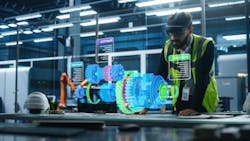Maintenance Mindset: Booming AR glass markets are a vision of the future
Welcome to Maintenance Mindset, our editors’ takes on things going on in the worlds of manufacturing and asset management that deserve some extra attention. This will appear regularly in the Member’s Only section of the site. This edition of Maintenance Mindset is the first Plant Services byline by our 2025 summer intern Maya Schwartz.
Key takeaways
- AR glasses are transforming traditional eyewear into immersive tools that enhance productivity, safety, and collaboration in industrial settings.
- With a projected CAGR of 59% through 2030, the industrial AR glass market is poised for growth, led by innovators like XReal, Vuzix, and Magic Leap.
- Advances in hardware miniaturization, tethered connectivity, and ergonomic design are promote rapid adoption in manufacturing.
- Integration with AI and IoT systems allows AR glasses to support real-time monitoring, remote assistance, and contextual decision-making on the floor.
Near-sighted or far-sighted, you probably need some good ole glasses. They’ve been around since the 13th century to aid with vision and enhance our perception of our surroundings. Just as fire changed how early humans interacted with the world, a surge in the augmented reality (AR) glass market is transforming traditional eyewear from accessories that sharpen sight into tools that enhance our environment. The world of operations and safety may never be the same.
Augmented reality glasses overlay virtual elements onto the lens, allowing users to interact with visuals and information through a simple gesture or hand-wave, like navigating a ‘screenless’ tablet (or having superpowers). There is growing potential for the use of this technology in manufacturing and logistics, especially in the automotive sector, to boost worker productivity, enable remote collaboration and strengthen safety training and risk prevention in precision-dependent environments. Regular glasses are so 21st century. Now we’re looking through the lens of the future.
Why the industrial AR glass market is poised to explode
Why the boom of AR glass now? The answer is easy enough: timing. With various refinements to the AR glass technology in the upcoming years, including AI integration and hardware miniaturization, the AR glass market is expected to grow from $0.98M to $9.98M between 2025 and 2030, with a compound annual growth rate (CAGR) of 59.0%.
Streamlined models with smaller components and ergonomic improvements allow for long-term comfort. The adoption of tethered AR reduces bulky technology by using 5G or WIFI connectivity to offload processing power onto a secondary device like a PC or dedicated computing pack and reduce heat. Because who wants to walk around with a mini space heater on their face? Answer: no one.
AR glasses extend their functionality through integration with enterprise software and Internet of Things (IoT) systems. When AR glasses operate as an IoT interface, users can remotely monitor, control, and interact with other devices, even contacting offsite technicians for real-time collaboration. This connectivity ecosystem enables workers to access critical data, like machine temperatures or technical issues, directly within their viewfinder, without looking away from the task at hand.
The future of AR glass includes AI integration for faster communication and decision-making
Artificial intelligence (AI) and generative AI (GenAI) are being paired with AR technology to increase functionality and scale the possibilities for AR glasses in everyday wear. AI and GenAI create 3D renderings and models to display on AR glass virtual interfaces, reducing time and cost for developers. AI can also recognize objects and provide contextual overlays that adapt AR glasses to complex environments and detail-oriented tasks. This advancement supports more immersive training, thorough safety inspections, and greater situational awareness.
For operations managers, AR glasses enhanced with AI spell incredible opportunity for heightened productivity, efficient performance and accurate documentation. Technicians can receive AI-generated overlays or step-by-step instructions directly in their line of sight, reducing downtime and enabling faster machine operation. They can also collaborate with remote experts in real time, walking through repairs to make immediate adjustments, minimizing the need for on-site visits. Finally, AR with integrated AI allows for seamless, passive data collection and machine monitoring with high accuracy and minimal disruptions to daily operations.
Several companies are pioneering the AI evolution. Keep an eye out for these market leaders:
- XReal Inc. offers XReal One, branded a “personal pocket projector” with advanced screen projection technology and low latency (20-30 ms) for real-time immersion.
- Vuzix Corporation is based in the US and produces a catalog of Vuzix AR glasses. Products integrate AI facial recognition, automated decision making, and personalized speech recognition to elevate functionality.
- Magic Leap, another US-based company, boasts high fidelity optics that blend 3D models into real-world visuals with a patented Waveguide technology.
For centuries, glasses have helped us correct how we see the world. Now, AR glasses are helping us see what’s possible. By layering intelligence onto our environments, AR glasses transform how we work and collaborate, helping us envision a smarter future for manufacturing.
About the Author
Maya Schwartz
Maya is a rising junior at Northwestern University, where she studies journalism and environmental engineering, along with a minor in business. She brings experience in technical writing, environmental consulting, and research-driven publishing, with a passion for bridging the gap between technical innovation and accessible communication.
